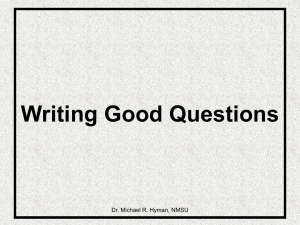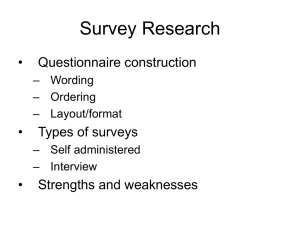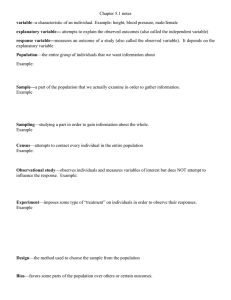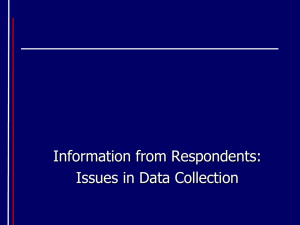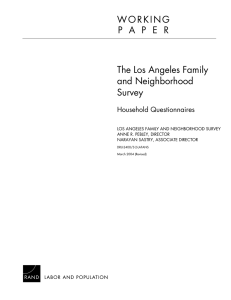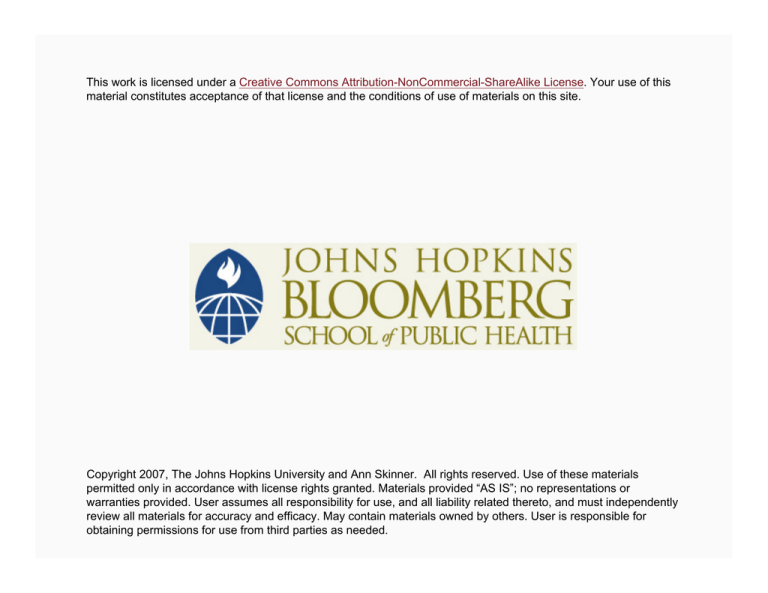
This work is licensed under a Creative Commons Attribution-NonCommercial-ShareAlike License. Your use of this
material constitutes acceptance of that license and the conditions of use of materials on this site.
Copyright 2007, The Johns Hopkins University and Ann Skinner. All rights reserved. Use of these materials
permitted only in accordance with license rights granted. Materials provided “AS IS”; no representations or
warranties provided. User assumes all responsibility for use, and all liability related thereto, and must independently
review all materials for accuracy and efficacy. May contain materials owned by others. User is responsible for
obtaining permissions for use from third parties as needed.
Survey Research: Designing an Instrument
Ann Skinner, MSW
Johns Hopkins University
Section A
Choice of Method
Characteristics of a Survey
It applies systematic methodology
It involves obtaining information directly from individuals
It involves selecting a subgroup from a larger group
It is done for the purpose of . . .
− Description
− Exploration
− Explanation
4
Tailored Survey Design
Sampling Issues
Whether to use probability sampling
− The sampling frame
− Size of the sample
− Sampling design/strategy
− Expected response rate
Sampling Issues
Question design issues
− Reliability and validity of items
− Pre-testing or pilot work
Interviewing issues
− Selection of interviewers
− Supervision
5
Questionnaire Design
Quantitative surveys in health services research
6
Traditional Survey Model
A carefully standardized
physical stimulus (i.e., question)
Interviewer
Respondent
A response (i.e., answer)
expressed in terms of a standardized
format provided by the researcher
7
Symbolic Interactionist View
Interviewer
Encodes question
Own purposes
Perceptions of
respondent
Respondent
Decodes question
Own purposes
Perceptions of
Interviewer
Interviewer
Decodes answer
Own presumptions
Perceptions of
respondent
Respondent
Encodes answer
Own presumptions
Perceptions of
interviewer
8
Methods of Data Collection
Self-administered
− Individually
− By mail
− In groups
− Internet or email
Interviewer-administered
− By telephone
− In person
9
Methods of Data Collection
Combinations
Self-administered with interviewer instructions
Mail with telephone follow-up
Interviewer-administered with embedded self-administered
section
10
Factors in Choice of Method
Characteristics of study population
− Literacy
− Physical and mental abilities
− Motivation
11
Factors in Choice of Method
Access to sample
− Location
− Time available for data collection
− Infrastructure available (telephones, mail service, internet
access)
12
Factors in Choice of Method
Availability of information about study population
− Telephone numbers
− Completeness of addresses
− Tracing information
13
Factors in Choice of Method
Survey objectives
− Complexity of questioning
− Difficulty of reporting task
− Topic sensitivity
14
Factors in Choice of Method
Question forms to be used
− Open-ended
X Fill in a number
X Write in text
− Closed-ended
X Multiple choice
X Scalar (likert-type)
X Dichotomous (yes/no)
15
Factors in Choice of Method
Expected response rates
Example (assume a group with interest):
− Mail survey with no follow-up—30%
− Mail survey with mail follow-up—50%
− Mail survey with telephone follow-up—60% to 80%
16
Section B
Guidelines for Writing Questions
Guidelines for Writing Questions
Restrain the impulse to write specific questions until you have
thought through your research questions
Write down your research questions and keep them handy
when you are working on the questionnaire
Every time you write a question, ask yourself . . .
− “Why do I want to know this?”
− “How will it help answer a research question?”
Notes Available
18
Open-Ended or Closed-Ended Questions?
Type of information sought
− Facts
− Opinions or attitudes
− Exploratory
Complexity of the information or difficulty of the reporting
task
19
Open-Ended or Closed-Ended Questions?
Feasibility
− Range of possible answers
− Coding capabilities
− Sample size
− Data collection method
20
Advantages of Open-Ended Items
Can get unanticipated answers
May describe the respondent’s real views better
Respondents can answer in their own words
Appropriate when the range of possible answers is long
21
Advantages of Closed-Ended Items
Task of answering is easier
Interpretation of the answer is easier
Avoids rare answers
22
Scales, Indices, and Questionnaires
Seek out appropriate scales, indices, questionnaires that have
been used and tested by others
Examples
− Health status scales
− Quality of life
− Mental health status
− Health services utilization
− Satisfaction ratings
23
Scales, Indices, and Questionnaires
Can combine several in one questionnaire
Be careful about copyrighted instruments
24
Writing Questions
Fully scripted, so that as written, the question prepares the
respondent to answer
The question means the same thing to every respondent
The respondent understands what an appropriate answer
should be
25
Common Pitfalls
Fuzzy Wording
Vague and general questions produce vague and general
answers
Bad—What do you like best about this neighborhood? We’re
interested in anything, like houses, the people, the parks, or
whatever
26
Poor Question Organization
Bad
“I would like you to rate different features of your
neighborhood as very good, good, fair, or poor. Please
think carefully about each item as I read it. Public schools.
Parks. Other.”
27
Poor Question Organization
Better
“I am going to ask you to rate different features of your
neighborhood. I want you to think carefully about your
answers. How would you rate the public schools—would you
say very good, good, fair, or poor?
How would you rate the parks, would you say very good,
good, fair or poor?”
28
Difficult Words
Risk miscommunication with respondent
Example:
− “Do you think TV programs are impartial about politics?”
29
Of 56 Respondents . . .
26—interpreted “impartial” correctly
10—overlooked the word altogether
9—thought it meant “tending to spend too much time on
politics”
5—thought it meant unfair or biased
2—thought it meant giving too little time to politics
7—had no idea
30
Negatives and Sneaky Double Negatives
Bad
“What is your view about the statement that conservationists
should not be so uncooperative with the government?”
31
Negatives and Sneaky Double Negatives
Better
“What is your view about the statement that conservationists
should be cooperative with the government?”
32
Asking Two or More Questions at Once
Bad
”When riding in the back seat of a car, do you wear a seat
belt all of the time, most of the time, some of the time, once
in a while, or never?”
33
Backseat Belt Question
34
Asking Two or More Questions at Once
Better
“In the past year, have you ridden in the back seat of a car?”
“When you are riding in the back seat of a car, do you wear a
seat belt all of the time, most of the time, some of the time,
once in a while, or not at all?”
35
Backseat Belt Question
36
Section C
Questionnaire Construction and Critique
Putting the Questionnaire Together
Item Order
Self-administration—capture respondent’s interest
Interviewer—allow for practice with question/response
format (information interviewer needs to know)
38
Putting the Questionnaire Together
Ideal Length
Self-administration—15–20 minutes
Interviewer—20–30 minutes
Testing
Read it aloud to yourself
Read it aloud to co-workers, friends
Ask two to three others to fill it out themselves
39
Systematic Pilot Testing
Small sample (10–15)
Similar to study population
Use all study procedures
Discussion of problem questions
40
Standard 10-Step Critique
Use simple unambiguous language that can be understood in
the same way by all respondents
Avoid long and complex sentences
Avoid hypothetical questions
Avoid “double-barreled” questions (asking two questions at
once and questions that include assumptions)
Notes Available
41
Standard 10-Step Critique
Do not ask questions that ask respondents for information
they do not have
Avoid questions that ask about causality
The time frame referred to in the question should be
unambiguous and explicit
42
Standard 10-Step Critique
For fixed response questions, response categories must be
exhaustive and mutually exclusive
Make sure the context of the question does not
inappropriately affect its meaning
Define terms as needed (complex definitions and instructions
should be given in a preamble or introduction, not in the
question itself)
43

